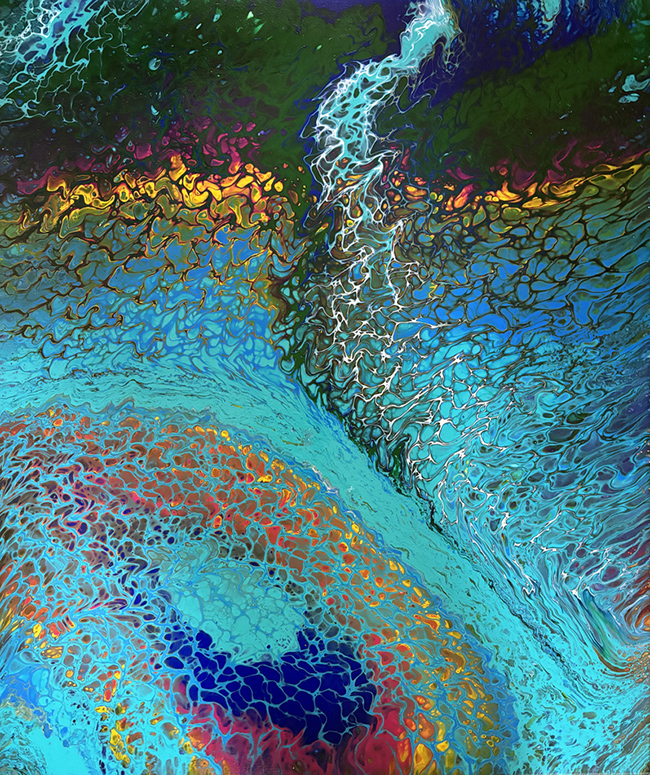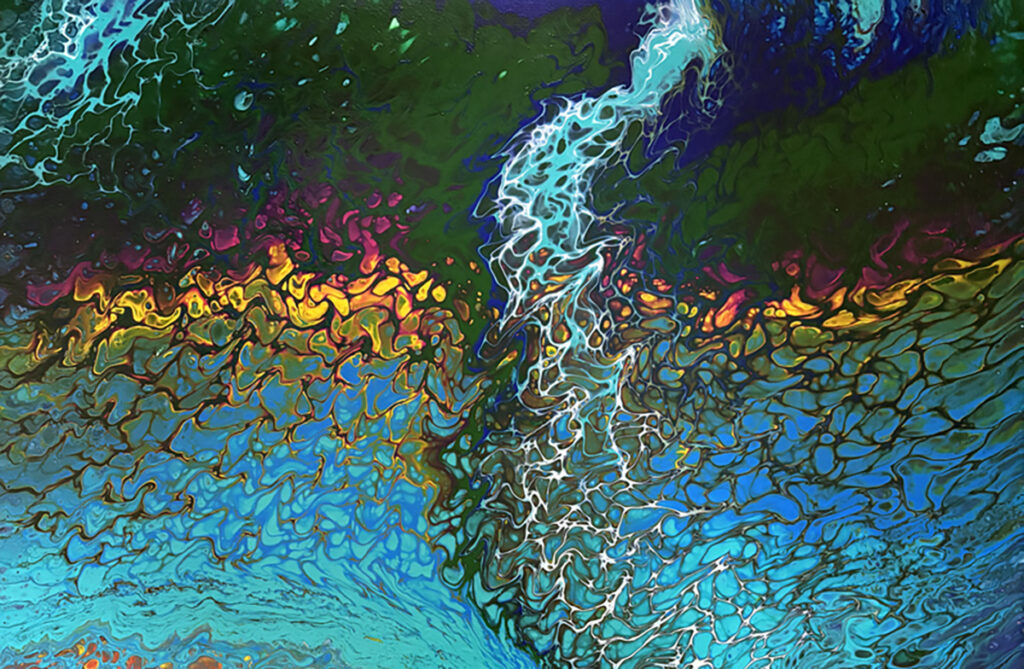Oenone Hammersley is an artist whose work keeps a close dialogue with the natural world. Her paintings carry the imprint of rainforests, rivers, and wildlife, offering both beauty and a quiet call to responsibility. Hammersley has long been fascinated by the ways light moves through leaves, how water reflects the sky, and how fragile ecosystems hold themselves together in balance. Her work blends a sense of realism with passages of abstraction, so the viewer is never simply looking at representation but also at mood and atmosphere. What emerges is an art that celebrates nature’s rhythms while pointing toward its vulnerability in a time of change. Sparkman’s paintings often evoke wonder, but they also ask us to pause, to think about what is fleeting and what must be preserved.

Rainbow River 4: A Conversation in Color
Rainbow River 4 (Acrylic on Canvas, 24” x 20”) is part of Hammersley’s Rainbow River series, a body of work that explores water not as static scenery but as something alive. In this painting, color itself becomes a stand-in for the restless surface of a river. Vibrant blues and deep reds move across the canvas, never quite settling, always shifting. The eye follows these colors as though following a current, carried along without resistance.
The painting works through tension—cool and warm tones placed side by side, each pulling against the other but never breaking the composition. The blues recall water at dusk, when daylight has faded but the river still holds light. The reds, meanwhile, introduce a sense of heat and urgency. Together, they create a push and pull that feels elemental, like fire meeting water in an endless conversation.
Textures play an important role here. Hammersley builds the surface so that it does not read as flat. Instead, it ripples with raised strokes, glazes, and layering. This tactile quality echoes the way rivers never sit still; they catch light, bend it, distort it, and send it back as fragments. In Rainbow River 4, the canvas mimics that shimmer, encouraging the viewer to lean closer, to look beyond the obvious.
Hints of green and gold emerge in subtle ways. They do not dominate the painting but appear like secrets. The green can suggest vegetation along the banks, glimpsed in reflection. Gold, on the other hand, feels like sunlight breaking through the canopy, or perhaps the memory of light preserved on water’s surface. These accents enrich the dialogue already present between blue and red, adding depth and complexity without overwhelming the eye.
The more one looks, the more forms begin to suggest themselves. Hammersley has said that layers can reveal new facets, and in this piece, an almost hidden face seems to appear. It is not literal, not drawn with line or contour, but implied through the interaction of shapes and shadows. The presence is ghostlike—there, and not there—inviting the viewer into a moment of contemplation. This face, or apparition, serves as a reminder that water carries memory, history, and spirit. It is never just a physical substance but also a container for meaning.
The strength of Rainbow River 4 lies in its openness. It does not prescribe a single reading. Instead, it offers an experience that changes depending on the viewer’s state of mind. For some, it might call up the quiet of walking near a river at dawn. For others, it could evoke the energy of rushing currents. Still others may see it as abstract emotion made visible—joy, conflict, serenity, or grief, depending on what one brings to the encounter.
Placed within the larger series, Rainbow River 4 extends Hammersley’s ongoing dialogue with nature. The series as a whole suggests that rivers are not just natural features but also metaphors for passage and transformation. They change constantly, just as we do. By painting them in vibrant abstraction, Hammersley underlines this truth while keeping the door open to personal interpretation.
Ultimately, the painting succeeds because it feels alive. The movement of color across the canvas mimics the unpredictable flow of water. The textures keep the surface in motion, even though it is fixed in paint. And the hidden forms invite viewers into an intimate exchange that rewards slow looking. Rainbow River 4 becomes not just an image of a river but an embodiment of one.
Through works like this, Hammersley continues to blend the real and the abstract, the seen and the felt. Her art is grounded in the observation of nature but reaches beyond into emotion, memory, and imagination. Rainbow River 4 is both beautiful and questioning, reminding us that rivers are more than scenery—they are lifelines, and they are fragile.

